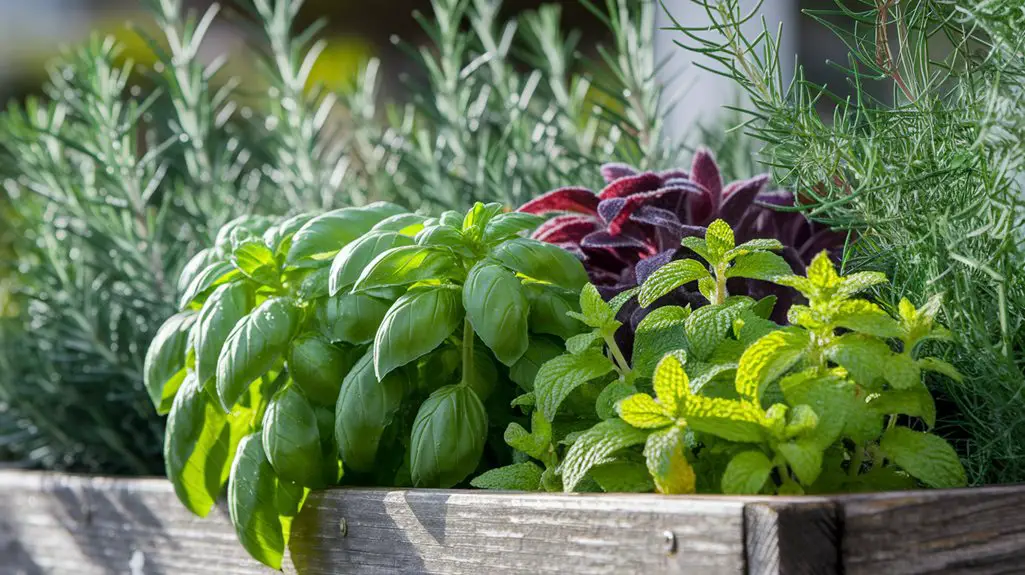Sunlight dapples through vibrant green leaves as your herb garden awakens with morning dew. You'll find that cultivating culinary herbs offers both gustatory and aesthetic benefits in any residential landscape. Strategic selection of Lamiaceae family members, Allium varieties, and Mediterranean species can transform your garden into a productive microcosystem. The right herbs not only enhance your cuisine but also attract beneficial insects and repel certain pests. Consider these top performers for your herbaceous collection.
Basil: The Versatile Kitchen Essential
Ocimum basilicum, commonly known as sweet basil, stands as an indispensable culinary herb for gardeners seeking both flavor and ornamental value. This annual herb thrives in Zones 4-10, preferring well-drained soil with pH 6.0-7.0 and full sun exposure for ideal essential oil production.
You'll achieve maximum leaf development by pinching the terminal buds before inflorescence formation.
Basil's cultivars offer remarkable diversity: 'Genovese' for traditional culinary applications, 'Purple Ruffles' with anthocyanin-rich foliage, and 'Thai' containing higher concentrations of limonene.
Harvest when internodal spacing remains compact, typically early morning when volatile oil concentration peaks.
Propagate via apical cuttings in water or directly from seed after soil temperatures exceed 60°F (15°C).
Companion planting with Solanum lycopersicum enhances both species' vigor while deterring Manduca quinquemaculata infestations. Additionally, basil is known to attract beneficial insects that aid in natural pest control, making it an ideal choice for organic gardens.
Mint: The Refreshing Perennial
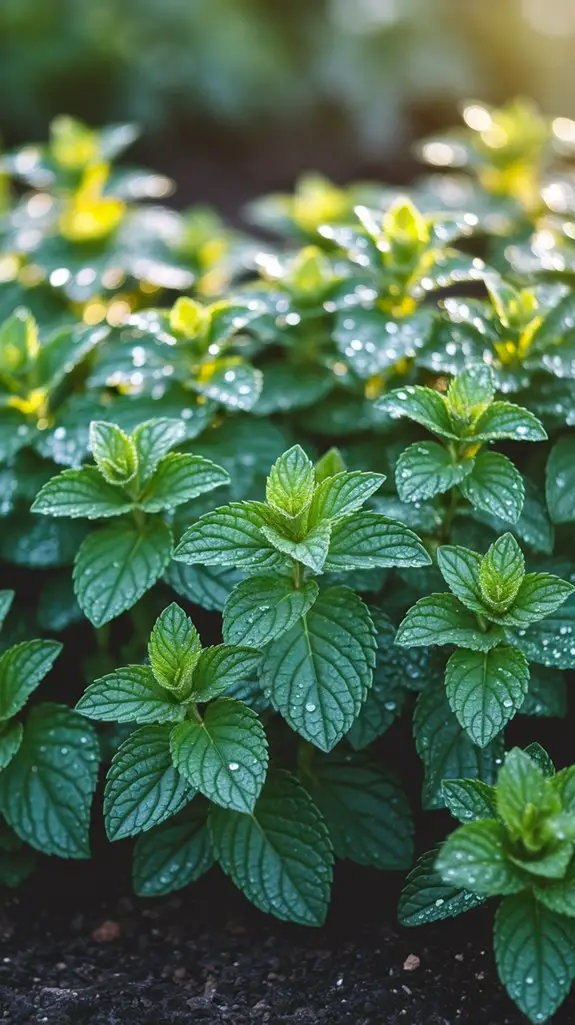
Mentha spp., comprising several hybridizing species including M. spicata and M. piperita, represents one of the most vigorous and adaptable perennial herbs for home cultivation.
You'll find mint thrives in partial shade with consistent moisture, establishing rapidly via stoloniferous growth.
Consider containment strategies, as mint's rhizomatous habit leads to aggressive colonization. Submerged pots or barriers extending 30cm below soil level effectively restrict lateral spread.
Harvest leaves pre-flowering for peak aromatic compounds, particularly menthol and carvone. Mint tolerates multiple harvests annually, responding with vigorous regrowth following each cutting.
For overwintering in zones 4-9, apply mulch at crown level. Taxonomic identification can prove challenging due to natural hybridization; however, aromatic profile remains the definitive cultivar indicator.
Propagation via stem cuttings guarantees genetic consistency, while division rejuvenates declining specimens every 3-4 years. Additionally, using kitchen scraps can enrich the soil around mint plants, boosting their growth and vitality.
Rosemary: The Fragrant Mediterranean Staple
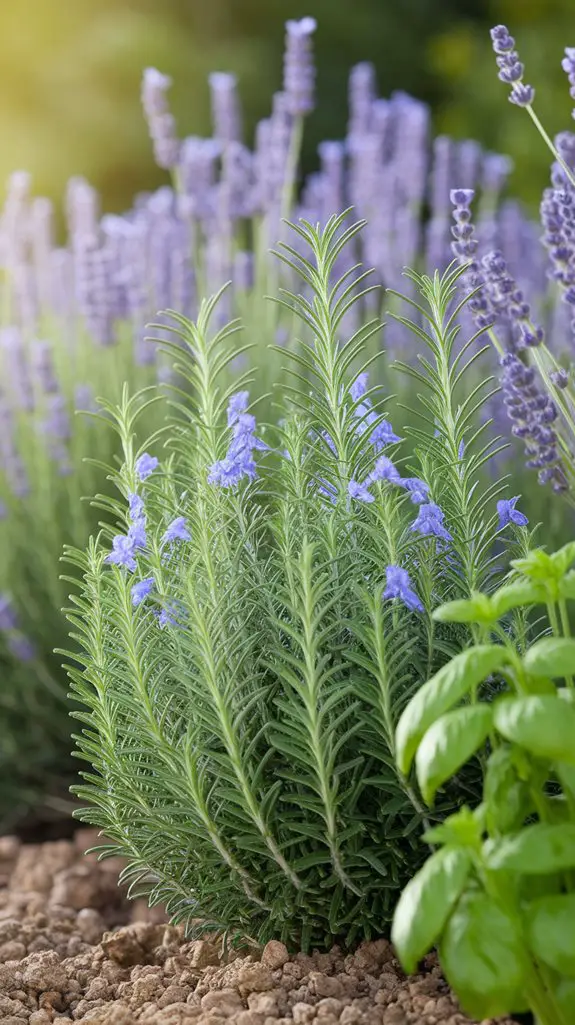
Native to the rocky coastal regions of the Mediterranean, Rosmarinus officinalis (now reclassified as Salvia rosmarinus) thrives in well-drained, alkaline soils with pH 6.0-7.5 and minimal irrigation once established.
This woody perennial exhibits xerophytic adaptations including needle-like leaves with stomata confined to abaxial furrows, reducing transpiration loss.
You'll achieve ideal growth in USDA zones 8-10, though selected cultivars tolerate zone 7 conditions.
Plant in full sun positions with 6+ hours daily exposure. Prune post-flowering to maintain compact habit and prevent lignification of older stems.
Harvest terminal shoots year-round, with peak essential oil concentration occurring pre-flowering.
The volatile compounds—primarily 1,8-cineole, α-pinene, and camphor—provide both culinary applications and documented antimicrobial properties against common food-borne pathogens. Additionally, rosemary can be successfully cultivated in container vegetable gardening, making it a versatile choice for backyard gardens.
Thyme: The Low-Maintenance Ground Cover
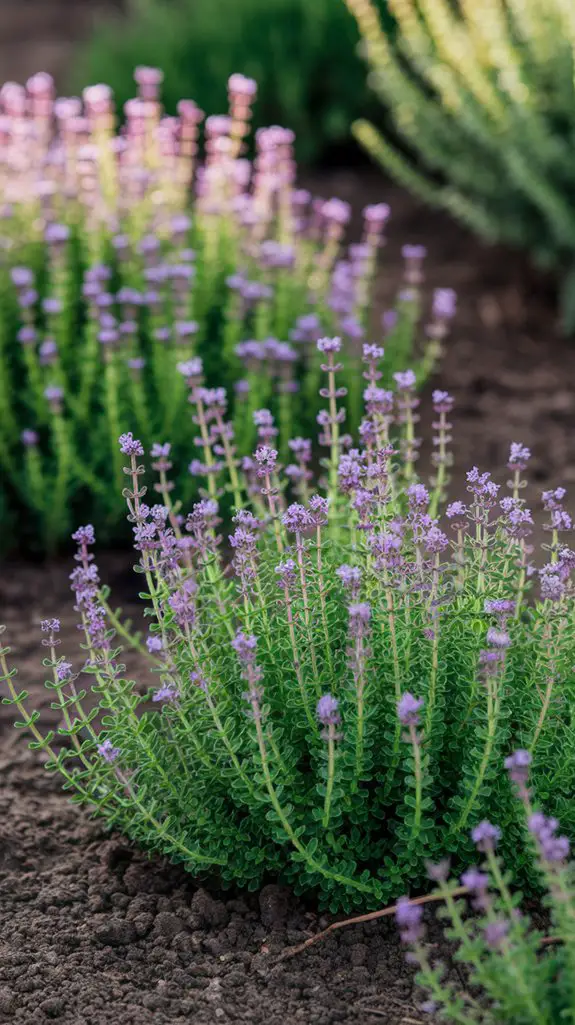
While rosemary commands vertical attention in the Mediterranean herb garden, Thymus vulgaris establishes itself as an exceptional horizontal companion, forming dense, aromatic mats rarely exceeding 30cm in height.
This perennial evergreen thrives in well-drained, slightly alkaline soils with full sun exposure.
You'll appreciate thyme's drought tolerance once established, requiring minimal irrigation even during arid periods. Its woody stems bear diminutive, elliptical leaves containing essential oils rich in thymol and carvacrol—compounds with documented antimicrobial properties.
Plant specimens 20-25cm apart to allow for lateral expansion. Pruning post-flowering prevents woodiness and stimulates new growth. Harvest before flowering for ideal oil concentration.
Common cultivars include 'Silver Queen' with variegated foliage and 'Orange Balsam' with citrus notes, expanding your culinary and ornamental options. Additionally, thyme is a great sustainable gardening choice because it supports local pollinators and enhances biodiversity in your garden.
Chives: The Pollinator-Friendly Allium
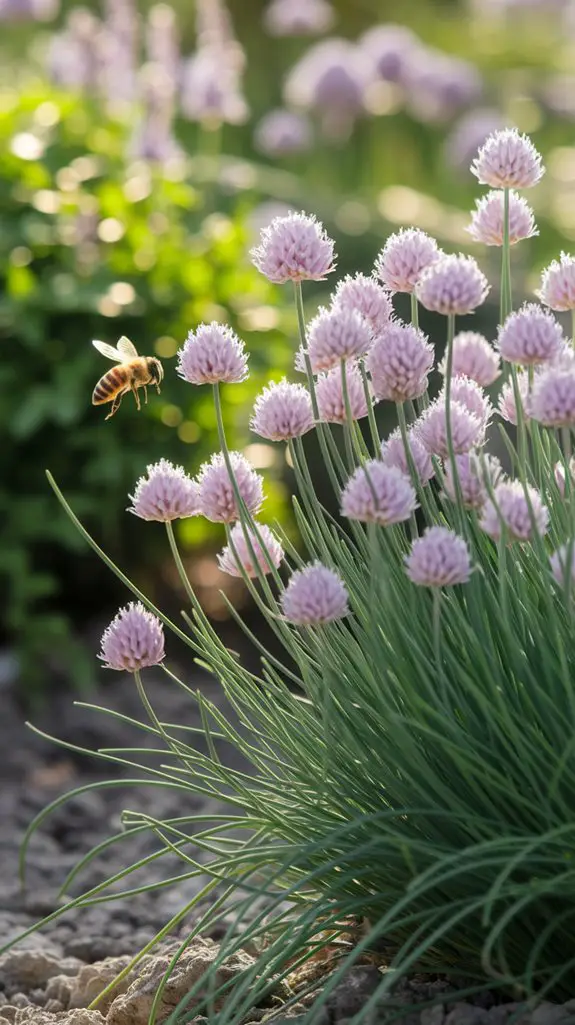
Unlike its Mediterranean counterparts, Allium schoenoprasum stands as a resilient perennial from the Amaryllidaceae family, forming neat clumps of hollow, tubular foliage reaching 20-30cm in height.
The lavender-pink umbels emerge in late spring, providing essential nectar for bees and syrphid flies when few other herbs are flowering. Chives are not only attractive to pollinators but also serve as a great companion plant for other herbs in your garden.
You'll find chives thrive in humus-rich, well-draining soil with pH 6.0-7.0.
Plant divisions 15cm apart in full sun to partial shade locations.
Regular harvesting encourages continuous production—simply snip 2cm above crown level.
For maximum pollinator benefit, allow several plants to flower.
The edible blossoms impart a mild onion flavor to vinegars and salads.
Divide congested clumps every 3-4 years to maintain vigor and prevent self-seeding throughout your garden beds.
Oregano: The Drought-Resistant Italian Classic
Origanum vulgare belongs to the Lamiaceae family, presenting a stark contrast to chives with its woody stems and aromatic, oval leaves containing essential oils rich in carvacrol and thymol. This perennial xerophyte thrives in Mediterranean conditions—rocky, calcareous soils with pH 6.0-8.0 and minimal irrigation requirements.
You'll find oregano exhibits ideal essential oil production when cultivated in full sun exposure with limited nitrogen inputs. Propagate via stem cuttings or crown division during spring. Prune 3cm above the crown post-flowering to encourage lateral branching and prevent lignification.
Harvest before anthesis when volatile compound concentration peaks—typically early morning after dew evaporation. For maximum potency, dry at 35°C in darkness to preserve essential oils.
Companion plant with Capsicum and Solanum species for integrated pest management, as oregano's terpenes repel Tetranychus urticae and Thrips tabaci. Additionally, sustainable pest management practices can enhance the effectiveness of your herb garden by minimizing harmful chemical use.
Parsley: The Nutrient-Rich Biennial
Petroselinum crispum represents one of the most nutritionally dense herbs in your potential cultivation portfolio, containing exceptional levels of vitamin K (1640% DV/100g), vitamin C (133% DV/100g), and myricetin flavonoids. This umbelliferous biennial thrives in zones 5-9, preferring well-draining, nitrogen-rich substrates with pH 6.0-7.0. Companion planting with parsley can enhance natural pest control in your garden.
| Variety | Characteristics | Cultivation Notes |
|---|---|---|
| Flat-leaf | Robust flavor, hardy | Direct sow post-frost, 1/4" depth |
| Curly | Decorative, mild taste | Germination: 14-21 days at 70°F |
| Hamburg | Edible root, cold-tolerant | Harvest roots at 3-4 months |
| Italian Giant | Large foliage, aromatic | Benefits from afternoon shade |
| Japanese | Heat-resistant, slow-bolting | Space plants 8-10" apart |
You'll achieve ideal germination by pre-soaking seeds for 24 hours. Parsley's allelopathic properties make it an excellent companion for Brassica species.
Cilantro: The Quick-Growing Favorite
Coriandrum sativum, commonly known as cilantro (herb form) or coriander (seed form), stands as one of the fastest-growing culinary herbs for your garden, completing its life cycle in a mere 45-70 days.
This Apiaceae family member thrives in cool temperatures between 50-85°F and requires well-draining soil with pH 6.2-6.8.
You'll achieve ideal germination by direct-sowing seeds 1/4 inch deep after frost danger has passed. Maintain consistent moisture during establishment but avoid waterlogging the shallow root system.
Implement succession planting every 2-3 weeks to guarantee continuous harvest before inevitable bolting occurs in response to heat stress.
Harvest by cutting outer stems when plants reach 6 inches tall. The entirety of cilantro—stems, leaves, flowers, and seeds—offers culinary applications, while also attracting beneficial pollinating insects to your garden ecosystem.
Lavender: The Aromatic Bee Magnet
| Parameter | Requirement | Management |
|---|---|---|
| Soil pH | 6.5-7.5 | Amend with lime if acidic |
| Watering | Minimal | Allow to dry between waterings |
| Spacing | 24-36" apart | Guarantees proper air circulation |
For peak essential oil production, harvest stems when flowers have just opened. Cut 1/3 of the foliage, leaving woody growth intact to facilitate regeneration. You'll notice pollinators—particularly honeybees—visiting frequently during flowering periods, making lavender an excellent companion plant that enhances garden biodiversity while deterring aphids from neighboring roses. Additionally, planting lavender can help support beneficial insects that play a vital role in pest control.
Conclusion
Growing these nine exemplary herbaceous specimens in your backyard garden will transform your culinary and horticultural experience. You'll witness unparalleled biodiversity as Lamiaceae and Apiaceae family members establish robust root systems while producing essential oils of incomparable potency. Remember to take into account each species' specific photosynthetic requirements, soil pH preferences, and moisture needs for ideal development. With judicious pruning and proper spacing, these aromatic perennials and annuals will reward you with harvests for countless generations.

